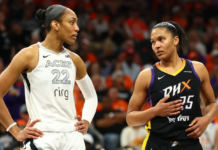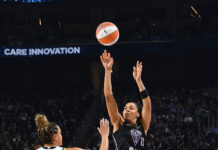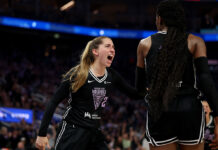It can be tough to know who to support during a sports season, especially if you don’t know much about the sport itself. As a result, having limited knowledge can lead many people to seeking third person perspectives, either from other sports fans, sports commentators during games, or perhaps the most impactful source on the rise, social media. And no one utilized social media more than the two biggest teams headlining this year’s Super Bowl — The Kansas City Chiefs and the Philadelphia Eagles.
This year, there were many football fans watching the Super Bowl solely for Kendrick Lamar’s half-time show. The NFL is no stranger to having neutral fans — on the contrary, the Super Bowl is arguably the biggest game of the year that motivates the most neutral of fans to choose a team to support.
Neutral fans don’t hold “alliances” to teams. While they contribute just as much to the passionate spirit of a game, many of them may not necessarily be educated enough on a team to invest in one in particular. Instead, many curious sports viewers do one thing when the season rolls around: go online.
Social media can play a huge role in the way a team or player is viewed by the rest of the sports world. Media content such as sports highlights and reels allow for sports fans to promote their team’s growth throughout the season and allow them to build a strong and loyal following. This especially benefits leagues, as it can lead to new sponsorships or even further funding from existing sponsors towards the teams.
However, when it comes to rallying fan support, social media is important, if not crucial, for the relevance of teams and their players. For example, months after the Kansas City Chiefs won Super Bowl LVII against the Philadelphia Eagles in a 38-35 victory, Travis Kelce, the 35-year-old tight end for the Chiefs, blew up internationally overnight as his relationship with pop star Taylor Swift went public in October of 2023.

Suddenly, everyone was a Chiefs fan, following Kelce and the teams every move. The Chiefs, who were once considered the underdogs of the NFL, found themselves overwhelmed. With the Chief’s fan base now expanding, they went on to win their third Super Bowl in five years, generating more traction than ever following the 2023-2024 season.
However, social media can easily become a double edged sword in the sports world. Just two weeks before Super Bowl 50, New England Patriots quarterback Tom Brady was accused of deliberately deflating balls used in the Patriots game against the Indianapolis Colts. The scandal cost Brady a four-game suspension and the Patriots two draft selections for the following 2015-2016 season.
Now, with social media becoming prominent, the Chiefs were no exception. Immediately, Chiefs fans became concerned that Kelce’s public relationship was overshadowing the spotlight from the rest of the team’s hard work. There were also conspiracy theories claiming the NFL worked in the Chiefs favor to scriptwrite the game and pay the referees behind the scenes in attempts to make sure Taylor Swift’s team win would attract more attention and interest in football.
The impact of the Chief’s social media presence followed them relentlessly. During the Super Bowl LVIII game against the San Francisco 49ers, many neutral fans were outraged during the game when the 49ers made the decision to receive the overtime kickoff to the Chiefs, essentially giving their opponent the leg up in the game. Their fury was fueled throughout the broadcast, when the screen kept panning to Taylor Swift, who made an appearance during the game as she attended to cheer Kelce on.
The irritation of constantly seeing her during the broadcasting prompted fans to create challenges to keep track of how many times they could track the camera on Swift during the game. In addition, multiple commercial appearances made by Chiefs favorites such as Travis Kelce and Patrick Malhomes, reigniting rumors that the Chiefs were being favored by the league.
So when the 2025 Super Bowl was rolling around the corner, many football fans were not surprised to see the Chiefs back again, with many Chiefs fans hoping to see Kansas City become the first team to win the Super Bowl three times in a row. However, social media has changed the public’s perception of the once beloved Kansas City Team, with many NFL fans coining the term “chief fatigue” to refer to constantly seeing players such as Travis Kelce, Patrick Mahomes and other Chiefs in constant media such as advertisements, reels and sports highlights.
It reached a point where football fans were coming together to make edits and highlights of other teams and players to cope with the inevitably boring game. Many Lamar Jackson and Josh Allen edits were circulating on platforms such as Tiktok and Instagram reels, desperate for any chance of a good game. Lo and behold, it presented a perfect opportunity for the Philadelphia Eagles fans to step in and use this opportunity to rally support for their team.

The Philadelphia Eagles, led by 26-year-old quarterback Jalen Hurts, have been infamously considered the underdogs of the NFL in recent years. That said, this year revealed a promising outcome for the team. In the 2024 season, the Eagles made one of their strongest teams of all time. This was made possible with the presence of notable players like Saquoen Barkley, Cam Jurgens, Landon Dickerson and Mekhi Beeton.
When paired up with their previous historical rivalry against the Chiefs, it created the perfect concoction of excitement for Eagles fans to use social media to their advantage and build up support from neutral spectators, and that is ultimately the support they needed to bulldoze through the Chiefs and earn their 40-22 victory. In that moment, it truly felt that every team in the NFL came together to celebrate the Chiefs losing.
While everyone has their own preferences and reasons, fans choose to support their respective teams because they look for a sense of belonging in the sports community. Some believe firmly in only showing loyalty to one’s own state team. With social media overshadowing the narrative, some people may resonate with the stories of certain players, and in turn, project their own dreams and desire for success onto them.
Regardless, the support motivates players throughout the game, resolidifying their value as members of their teams, and reminding them to pride in the jerseys they wear on their backs. Regardless, social media should not be the endgame when it comes to supporting teams, because it overshadows the unity aspect of sports, and takes away from getting to know the teams and the players behind the game.







